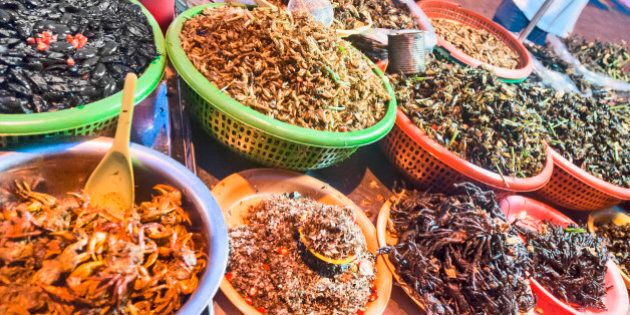
At the recent Institute of Food Technologists annual meeting in Chicago, "alternative" proteins were a hot topic. From laboratory-produced ground beef to the eco-benefits of insects as a protein source, many scientists believe we need to shift our palates from traditional proteins to more sustainable options. How does algae stack up against chicken? Could you swap your steak for some crickets?
Current projections suggest global food shortages are likely by 2050, when the world's population is expected to reach nine billion. It's not just staggering population growth to blame for the impending food crisis -- the forecast is particularly dire when coupled with the unsustainable growth in milk and meat consumption among those with booming populations.
While kcalories (kilocalories) per person/day from livestock (meat or dairy) has remained stable in North American and the European Union (read: still pretty high), meat and milk consumption is growing dramatically in China and India -- where nearly 40 percent of the world's population live. Given the environmental impact of "factory farming" agriculture, we need to not only shift our eating patterns and waste less valuable food, but also find protein sources that are less environmentally damaging. This is where algae and insects come in...
Reproducing quickly with small eco-footprints, these foods are proposed as sustainable and nutritious alternatives to traditional proteins. For today's Food Fight! we are comparing 100 g edible portion of:
- Lean ground chicken and beef. Chicken breast and filet mignon seemed frivolous choices in discussions of feeding the world.
- Organic, farmed-raised tilapia from re-circulated aquaculture systems. Don't get your ire up! Farmed tilapia can be VERY sustainable. Check out what Seafood Watch says if you don't believe us.
- Pigeon peas. We chose this "poor man's" legume for it's high protein content and drought resistance.
- Quinoa. Because it was name-dropped at the Institute of Food Technologists annual meeting.
- Likewise, algae and insects. We went with dulse because there's a bacon-flavoured one (!) and crickets since we've had them before - albeit sour cream 'n' onion flavoured crickets -- and they were not too bad. Crickets are popping up everywhere too, like protein bars.
No Baloney's results?Wow. Admittedly, we were skeptical. Still cannot believe we are going to say this, but objectively speaking insects take the win! Our second pick? We're calling it a tie between pigeon peas and tilapia owing to their excellent protein per dollar ratios and low "eco foodprint". While we do think dulse can be a nutrient dense snack, you would have to eat an awful lot for it to contribute a significant source of protein.
With nearly three times the protein of traditional meat, fish and poultry, crickets may be extremely high in kcalories, however, the protein-to-kcalorie ratio is still very high, behind only fish and dulse. Crickets also contain 19.1 g of fibre per 100 g -- that's three times as much as pigeon peas and seven times more than quinoa! In terms of micro-nutrients, per 100g serving crickets contain more calcium than milk, more potassium than banana and more iron than a steak! Not to mention over 100 percent of the RDA for most B-vitamins.
Yes, the total fat content is high, which explains the kcalories. Incidentally, this may be a good thing if we are talking about eliminating protein-energy malnutrition. Of the fat content in crickets, it's a pretty even split between saturated, monounsaturated and polyunsaturated fat. Although not quantified in crickets, there are some heart-healthy omega-3s in insects, most notably high amounts of alpha-linolenic acid (ALA) in silkworm larvae. Yum! If you're after DHA and EPA (found naturally in fish), entrepreneurial insect farmers are trialling fish meal feeding to boost levels in their insects with great success (Rumpold & Schlüter, 2013).
The (current) downside to consuming insects? Cost. When comparing protein grams per dollar, crickets are roughly twice as expensive as beef or chicken...but this does not consider environmental costs associated with agriculture. Hopefully as crickets and other insects gain in popularity, prices will drop as production increases. In the meantime, if you are feeling adventurous, Next Millennium Farms in Lakefield, Ontario has some cricket flour and flavoured cricket snacks for sale! They even have recipes... cricket banana bread, anyone?
MORE ON HUFFPOST:
